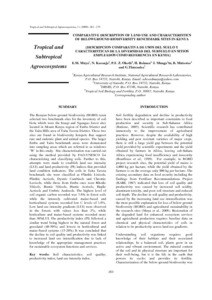Resource information
In Kenya, the below-ground biodiversity (BGBD) project selected two benchmark sites for the inventory of soil biota; these included the Irangi and Ngangao forest sites in the Mount Kenya region of Embu District and the Taita Hills area of Taita Taveta District. The areas selected by the project were located in biodiversity hotspots that are supporting rare and endemic plant and animal species. For more in-depth studies and analysis, the broader Embu and Taita benchmark areas were further sub-sampled into smaller areas that we refer to as study areas, designated by the symbols E1 and E2 for Embu and T1 and T2 for Taita benchmark. Within the study areas, we plotted and sampled 200x200 square grids for collecting soil as well as socio-economic data. Site characterization was carried out using the method provided by FAO-UNESCO for characterizing and classifying soils. Further to this, attempts were made to establish land use intensity (LUI) and land productivity (PI) indices that provided land condition indicators. The indicators offered insights into the quantitative relationship between the environmental conditions and land use. Parameters used in the computation of the land use intensity were; total quantity of inputs per ha, the frequency of input application, cropping intensity and cultivation frequency. The soils in Taita Taveta benchmark site were classified as Plinthic Lixisols, Plinthic Acrisols, Dystric Cambisols and Chromic Luvisols, while those from Embu ones were Rhodic Nitisols, Humic Nitisols, Humic Acrisols, Haplic Acrisols and Umbric Andosols. The highest level of soil organic carbon recorded was 7.6% in the forest and the lowest value of 1.6% in intensely cultivated maize-based and horticultural systems. Low land use intensity gradients were observed in the forests (LUI40%). The productivity index (PI) followed a similar trend, being highest in the natural forest and grassland (40-50%) and lowest in horticultural and maize-based systems (15-20%) It was concluded that the decline in soil quality and productivity was linked to increased land use intensification and lack of knowledge of the appropriate management practices for sustainable ecosystem functions and services.


